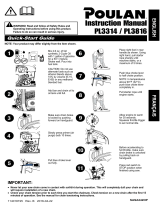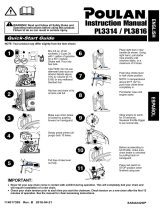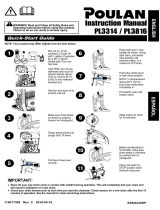
25 EN
INTSTRUCTIONS FOR USECHAINSAW
Cutting
stop immediately even at full engine speed. If the chain stops slowly or doesn‘t stop at all,
please replace the brake jaws and the clutch drum before further use.
It is extremely important that the chain brake function and chain sharpening status should be
checked before each use in order to keep necessary safety level of the saw in case of a
kickback. Overriding safety devices, incorrect maintenance or using inappropriate bar or
chain may lead to serious injuries in case of a kickback.
Tree felling (fig. 22)
Please determine the tree falling direction considering wind direction, tree inclination and
location of branches as well as all other factors before you start the work.
The tree surrounding area must be open, free of obstacles and allow your stable position to
be taken. The escape route must be passable.
Please make a wedge notch down to a third of the trunk diameter on the side where the tree is
supposed do fall.
On the opposite side, please make a separation cut above the wedge notch level.
CAUTION! When felling trees, please warn other persons in the neighborhood of a potential
hazard.
Wedge notch (1) (fig. 22)
Separation cut (2) (fig. 22)
Falling direction (3) (fig. 22)
Debranching and trunk felling
CAUTION! Always keep a stable position. Keep off the chunks.
The chunk being cut may roll away. Always stand above the chunk being cut especially when
working on a slope
Take precautions against the saw kickback by following the instructions described in the
„Safe operation“ chapter.
Before you start, please evaluate the direction of the cut trunk bending force. Make sure
you always make the final cut on the opposite side of the trunk bending force action to
prevent clamping the bar inside the section.
A Chunk lying on the ground (fig. 23).
Cut in half, then turn around and finish the cut from the opposite side.
B Chunk above the ground (fig. 24).
In the „A“ section, make a cut up to a third of the chunk from beneath, then finish the cut from
above. In the „B“ section, make a cut up to a third, then finish the cut from beneath.
Debranching a fallen tree (fig. 25).
At first, determine the direction in which the branch is bent. Then, make an initial cut from the
bending side and then finish the cut from the opposite side.
CAUTION! A bent branch may fling.






















